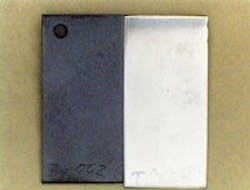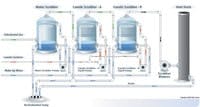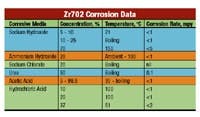It can be said that from the very first day a new plant or process is put into service, the battle against corrosion begins. The correct materials of construction can strike the proper balance between risk and cost.In many cases, corrosion rates are manageable. Materials selection often is based on a simplified economic analysis of materials cost versus estimated equipment life. In many situations, information about the process that may not have been accessible to the design team or was not initially taken into account becomes available once the plant or process is commissioned. As a result, corrosion rates that once were considered tolerable and manageable aren’;t any longer.In such cases, the materials of construction will have to be upgraded for the plant to reach a desirable level of operational reliability and economic performance. If the process or plant does not have a large buffer or green zone between it and population centers or public areas, then upgrading the materials of construction is more critical. Not upgrading materials when they are needed can lead to potential civil or criminal penalties, as well as continued economic losses due to unplanned outages. Neutralize acid attack
Consider a particular chlorine scrubber system that removes various chlorinated compounds from a process gas stream. In the first part of this process (Figure 1), a gas stream containing chlorinated compounds enters the bottom of the water scrubber (8 ft. 3 20 ft.), which uses a water spray to treat the gas. The scrubber operates at ambient temperature and a pressure of about -2 in. H2O.Process Flow Stream
Consider a particular chlorine scrubber system that removes various chlorinated compounds from a process gas stream. In the first part of this process (Figure 1), a gas stream containing chlorinated compounds enters the bottom of the water scrubber (8 ft. 3 20 ft.), which uses a water spray to treat the gas. The scrubber operates at ambient temperature and a pressure of about -2 in. H2O.Process Flow Stream
Figure 1. Chlorinated gas enters a water scrubber, followed by caustic scrubbers A and B. Equipment in this section was prone to failure do to corrosion and abrasion.
The primary function of the scrubber is to remove any silicon tetrachloride and any solid particles that enter the scrubber with the gas. Silicon tetrachloride reacts with the water to produce silicon dioxide (silica) and hydrochloric acid.SiCl4 + 2 H2 ---> SiO2 + 4 HClThe liquid exiting the water scrubber typically operates in a pH range of 1 to 2 and is very abrasive due to the presence of silica particles. The original 316 SS recirculation pumps did not last long. The pumps’; wet-end assemblies were replaced about every two to three months due to loss of flow and discharge head. The pump impellers and volutes were severely damaged by erosion and corrosion. The pumps’; wet-end assemblies were first upgraded to Monel alloy and then graphite, followed by Alloy 20. These materials were selected for their corrosion-resistant properties and cost, but none of them lasted longer than two to three months due to the liquid’;s corrosive and abrasive nature. The problem eventually was resolved by using air-oxidized Zr702 cast, wet-end pump assemblies. They were installed 17 years ago and are expected to last another 17 years.Why has zirconium worked so well where other materials have failed? The key is in one of its unique properties. Zirconium naturally forms an adherent, self-healing protective oxide film that protects it from chemical attack. This protective oxide film can be further enhanced by heat-treating zirconium in air at 1022°F (550°C) for four to six hours. This heat treatment forms a thick black oxide film on the zirconium surface (Figure 3) that resembles ceramic and gives the zirconium excellent abrasion- and erosion-resistant properties. The black oxide layer has a hardness equivalent to sapphire (Mohs hardness of 9).
The primary function of the scrubber is to remove any silicon tetrachloride and any solid particles that enter the scrubber with the gas. Silicon tetrachloride reacts with the water to produce silicon dioxide (silica) and hydrochloric acid.SiCl4 + 2 H2 ---> SiO2 + 4 HClThe liquid exiting the water scrubber typically operates in a pH range of 1 to 2 and is very abrasive due to the presence of silica particles. The original 316 SS recirculation pumps did not last long. The pumps’; wet-end assemblies were replaced about every two to three months due to loss of flow and discharge head. The pump impellers and volutes were severely damaged by erosion and corrosion. The pumps’; wet-end assemblies were first upgraded to Monel alloy and then graphite, followed by Alloy 20. These materials were selected for their corrosion-resistant properties and cost, but none of them lasted longer than two to three months due to the liquid’;s corrosive and abrasive nature. The problem eventually was resolved by using air-oxidized Zr702 cast, wet-end pump assemblies. They were installed 17 years ago and are expected to last another 17 years.Why has zirconium worked so well where other materials have failed? The key is in one of its unique properties. Zirconium naturally forms an adherent, self-healing protective oxide film that protects it from chemical attack. This protective oxide film can be further enhanced by heat-treating zirconium in air at 1022°F (550°C) for four to six hours. This heat treatment forms a thick black oxide film on the zirconium surface (Figure 3) that resembles ceramic and gives the zirconium excellent abrasion- and erosion-resistant properties. The black oxide layer has a hardness equivalent to sapphire (Mohs hardness of 9).
Support the resistanceIn the next step of this process (Figure 1), the gas enters the bottom of a packed scrubber (caustic scrubber-A, 10 ft. 3 30 ft.). Chlorinated compounds are reacted out with a 20% sodium hydroxide (caustic) solution. In this environment, chlorine compounds form oxoacids and oxoanions, such as sodium hypochlorite (ClO-), chlorite (ClO2-), chlorate (ClO3-) and perchlorate (ClO4-) ions. The liquid exiting the caustic scrubber usually is controlled at a pH of 9 but occasionally will cycle between 2 and 11 due to instrument problems and process variances. The scrubber operates at ambient temperature and a pressure of about -2 in. H2O.Caustic scrubber-A is made of fiberglass with a high-density polytetraflouroethylene (PTFE) liner to protect the fiberglass against attack from the oxoacids and oxoanions. The original liquid pumps were made of 316 SS, whereas the original liquid distribution trays and packing supports were made of polyvinyl chloride (PVC). After one year in service, the original liquid pumps, distribution trays and packing supports all showed signs of advanced corrosion and deterioration and were approaching failure. The pump impellers were severely thinned and reduced in diameter. The PVC parts were flaking, brittle and beginning to sag. In this strong oxidizing chloride environment, zirconium again was chosen to address the problem. Zirconium can tolerate both very acidic and very alkaline environments (Table) better than other corrosion-resistant materials, such as titanium, tantalum, graphite, glass and PTFE. The caustic scrubber liquid pumps, distribution trays and packing supports were replaced with Zr702. In this case, the zirconium required no special oxide or heat treatment before use. The zirconium equipment has been in service for 16 years, shows no noteworthy signs of corrosion, and is expected to last another 16 years. Strike a blow against corrosion The gas from caustic scrubber-A flows into the bottom of a second packed scrubber (caustic scrubber-B) for final treatment before being discharged to the atmosphere (Figure 1). Since the level of oxoacids and oxoanions formed here is small, caustic scrubber-B is not PTFE-lined, but is otherwise identical to scrubber-A. The polished gas then enters the blowers and is sent to the vent stack.The blowers operate at ambient temperature and at 1,800 rpm. The discharge pressure is about 3.5 in. H2O. The original blower wheels (48-in., closed radial) were made of rubber-coated mild steel. The wheels were not made entirely of rubber or plastic because of concerns about strength. Although rubber or plastic wheels could perform reliably at lower speeds, the capacity of the blowers would have been compromised.Non- and Heat-Treated Zr702
Figure 2. When zirconium is heat-treated, it forms a thick black oxide film on the surface (left) that resembles ceramic and gives the zirconium excellent abrasion- and erosion-resistant properties.The rubber coatings peeled off the metal wheels about every three to four months, causing high vibration in the blowers that resulted in shutdown for maintenance. A polyvinylidene fluoride (PVDF) coating was tried but also failed in the same time frame and manner. Alloy 20 wheels were installed but failed due to stress cracking and generalized corrosion.The blower wheel failures were attributed to attack by entrained liquid droplets in caustic scrubber-B’;s overheads. A knockout drum was proposed but rejected due to high estimated costs. Its installation would require major structural and piping modifications due to limited space. The solution to the blower wheels problem was to fabricate new blower wheels (Figure 3) from Zr702. The zirconium did not require oxide or heat treatment for this service. The blower wheels have been in service for 15 years with no remarkable signs of corrosion. It should be noted that the blowers’; casings are rubber-lined as originally designed.Scrubber Blowers
Figure 3. The blower wheels are made of Zr702. They have been in service for 15 years.
Making the gradeThe original materials of construction chosen for this chlorine scrubber system (fiberglass, PVC, PTFE, rubber liners and coatings) have proved to be reliable and cost-effective. The only exceptions were the water scrubber’;s recirculation pumps, the caustic scrubber’;s liquid pumps, liquid distribution trays, packing supports and blower wheels, which were upgraded to Zr702.The initial cost of the zirconium has paid for itself many times over by increasing operational reliability and reducing maintenance costs, as well as drastically reducing the risk of exposure to chlorinated compounds of plant personnel, the community and the environment. CPStan Kirsch is senior engineer of technical marketing for ATI-Wah Chang in Albany, Ore. He has more than 17 years of experience in the chemical industry and is involved in the day-to-day operations involved in engineering and maintenance of chemical process equipment.
Making the gradeThe original materials of construction chosen for this chlorine scrubber system (fiberglass, PVC, PTFE, rubber liners and coatings) have proved to be reliable and cost-effective. The only exceptions were the water scrubber’;s recirculation pumps, the caustic scrubber’;s liquid pumps, liquid distribution trays, packing supports and blower wheels, which were upgraded to Zr702.The initial cost of the zirconium has paid for itself many times over by increasing operational reliability and reducing maintenance costs, as well as drastically reducing the risk of exposure to chlorinated compounds of plant personnel, the community and the environment. CPStan Kirsch is senior engineer of technical marketing for ATI-Wah Chang in Albany, Ore. He has more than 17 years of experience in the chemical industry and is involved in the day-to-day operations involved in engineering and maintenance of chemical process equipment.
About the Author
Stan Kirsch
Stan Kirsch
Sign up for our eNewsletters
Get the latest news and updates




